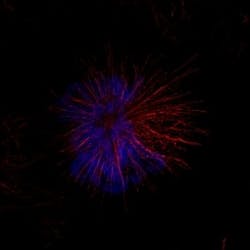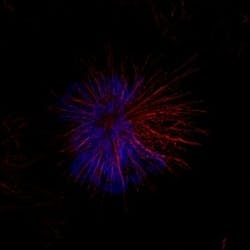Structured illumination microscope helps IU researchers to better understand protein distribution in cells
A new laser-equipped microscope at IU Bloomington's Light Microscopy Imaging Center makes it possible for microbiologists, cell biologists, and neurobiologists in particular to examine biological samples with unprecedented detail in three dimensions.
The imager is exceptionally fast in collecting images of a biological specimen to enable scientists to gather crucial data. The device uses laser light of four different colors to illuminate samples, while four extremely sensitive digital cameras capture images every 10 ms at the imager's fastest setting. The device can produce as many as 5,000 full-color images per minute for its major task of producing high-resolution images. Known as a structured illumination microscope, the device will help IU scientists attain a better understanding of how proteins are distributed inside cells with unprecedented resolution.
A fixed PTK (marsupial kidney cell line) cell in mitosis. The condensed chromosomes are stained with Hoechst stain and are shown in blue, while microtubules are labeled with an antibody to tubulin and are shown in red. Imaging was done in the structured illumination mode. More than 2,000 images were taken and processed to create this image. (Image by Eric Workman and Jim Powers)
The DeltaVision OMX microscope that IU has acquired can produce clear images down to 100 nm in the lateral dimension. Resolution along the z-axis is somewhat lower, but still tremendously improved relative to previous technologies.
Light Microscopy Imaging Center (LMIC) Manager Jim Powers is responsible for training IU researchers—as well as visitors—to use the device. Since the LMIC is a user-oriented resource, he says, scientists rent time on their devices and receive the appropriate training, with the expectation that they'll be able to work independently afterwards.
IU scientists get a reduced rate when using the LMIC's many microscopes, due to the generous support from OVPR, the College of Arts and Sciences, Medical Sciences, and Optometry. At present, the OMX is still in a training mode in which Powers is working closely with Sid Shaw, an assistant professor of biology and the technical director of the LMIC, as well as IU research staff to calibrate the device and establish protocols for future, similar uses. The LMIC staff expects the instrument to be available to all IU researchers by September.
The arrival of the DeltaVision OMX microscope has spurred Walczak, Shaw, and Powers to consider LMIC's future needs. Partly because of the DeltaVision OMX's size, the LMIC is now out of physical space. In addition, the device produces so much data (4,000 images takes up about 1.5 GB of hard drive space), Walczak and Powers said one of the center's next priorities is to improve the center's information technology infrastructure through continued collaboration with IU's Information Technology Services. Walczak and Powers want to ensure that the large data sets produced by the OMX imager can be stored rapidly—as well as protected from power outages and other catastrophes.

